Return to Shironagasu Island is a murder mystery and horror visual novel which was first released in Japan in 2018. An English version was released in 2020. The game is played from the perspective of Sen Ikdea, a New York-based detective, as he works with Neneko Izumozaki, a genius-but-socially-challenged high school student, to unravel the disturbing mysteries of Shironagasu Island. Below, you will find my special Halloween review of Return to Shironagasu Island.
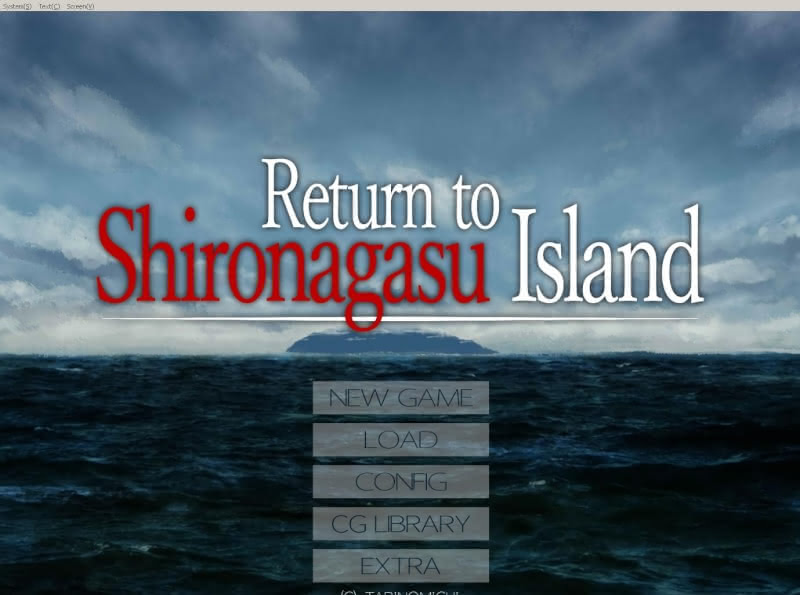
Note: I discovered after completing Return of Shironagasu Island, which had been sitting in my Steam library for some time, that a new and improved version of the visual novel with full voice acting is being released on Steam and for the Nintendo Switch in a couple of weeks. Do note if you are reading this review after that release that this review is of the original version without voice acting.
Non-Spoiler Note
This review will introduce the plot and a few of the main characters of Return to Shironagasu Island in general terms. I will not discuss the plot in ways that would spoil it for someone who has not played the game, so you may consider this review amenable to the purpose of deciding whether you want to add the visual novel to your collection. The non-spoiler commitment will greatly limit my discussion of the plot.
Return to Shironagasu Island Details
General facts…
| Title | Return to Shironagasu Island |
|---|---|
| Japanese Title | Shironagasu Tou e no Kikan |
| Release | JP (12.30.18), EN (10.31.20) |
| Developer | Tabi no Michi (Hyogo Onimushi) |
| Engine | KiriKiri |
| Platform | Windows |
| Store | Steam, Itch.io |
| Visual Novel Database | Entry |
I learned that Return to Shironagasu Island uses the KiriKiri visual novel engine from a Steam review of the game by a user who goes by ExtremeTeaDrinker. While this review is not related to my ongoing project to review nearly 30 early-2000s freeware visual novels from Japan, it is worth noting that KiriKiri is an old visual novel engine, so old that it powered three of the visual novels from that project – including Summer, Cicadas, and the Girl, which I reviewed in June. The top menu bar of Return to Shironagasu Island is identical to that of Summer, Cicadas, and the Girl (which was first released in 2005), thus highlighting the KiriKiri connection.
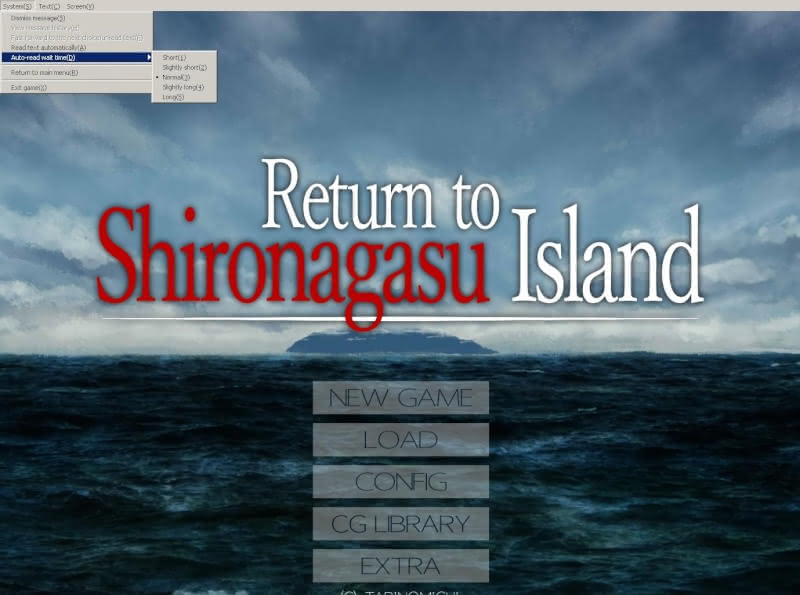
You will find that the top menu bar has a distinct 1990s computing aesthetic.
Note on Linux Compatibility
I had purchased Shironagasu on Steam a while ago when it was on sale. Thus, my review is based on the Steam version. Return to Shironagasu Island is only available for Windows, and I run Linux. However, it ran almost perfectly on my computer without my needing to fiddle with Steam’s Proton configuration. Other Linux-users have reported similar success.
The only two issues I had were that I could not use the top-menu (courtesy of KiriKiri) in fullscreen mode, but it works fine in windowed mode (the full-screen issue applies with older KiriKiri games too). I also could not get Steam screenshots to work, which is an issue noted in at least one ProtonDB review. However, other than those two issues, Shironagasu ran as well as a native Linux game on my set-up. I assume I would have no difficulty running the Itch.io version outside of Steam, but I have not tested it.
(For whatever it is worth, the three visual novels from the 2006 al|together festival that were built with KiriKiri instead of Nscripter/Onscripter were the only three with no native Linux versions.)
Note on DRM
The Steam version of Return to Shironagasu Island requires Steam to launch. There is a DRM-free version of the game on Itch.io. Do note that this review was published before the remastered version of the visual novel was released.
General Overview of Return to Shironagasu Island
Return to Shironagasu Island begins at Kennedy Airport with the player taking the role of Sen Ikeda, a local detective. He is waiting at the airport to pick up Neneko Izumozaki, a Japanese high school student who is fluent in 20 languages and has a photographic memory, but who is painfully socially challenged. Ikeda has a strange experience while waiting for Neneko at the airport.
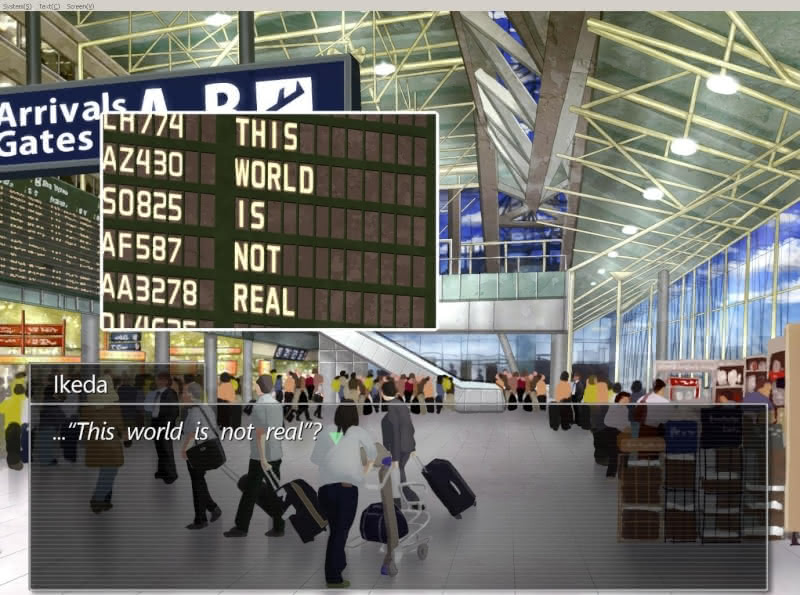
Ikeda brushes off the strange experience and retrieves a lost and petrified Neneko. While at the airport, he receives a phone call from one of his clients, Ada Higgins. Ikeda had been working for Higgins to discover why her father had suddenly become paranoid. He arrived at her home to discover that her father had committed suicide. With some help from Neneko and her photographic memory, the three discover that the late Mr. Higgins had received an invitation to Shironagasu Island. Ada Higgins pleads with Sen Ikdea to go as her family’s representative and discover the mysteries surrounding her father. Ikeda agreeds, and Neneko begrudgingly joins him because she does not want to be left behind in New York City. En route to Shironagasu Island, Ikeda declares that Neneko will be his assistant and that he will need her considerable knowledge and abilities in what may prove to be dangerous territory.
In the interest of keeping the review free of major spoilers, I am severely constrained in what I can say about Shironagasu Island proper. Ikeda and Neneko arrive with nine other guests from different parts of the world. After meeting the characters, some of whom seem pleasant and others less so, they are ushered to their rooms on the cold, barren island. It is not long after the guests are gathered in the dining hall that the unpleasantness begins. From that point on, Ikeda and Neneko will have to solve murders, avoid being murdered, and ultimately figure out what in the world is happening on Shironagasu Island.
How Long is Shironagasu?
Visual Novel Database reports that Return to Shironagasu Island takes 10 hours to read. While I did not play through it with an eye on tracking time, I came out at just under 10 hours (albeit I left it on a few times and returned to scenes to try different choices). Balancing my detours with the fact that I am a relatively fast reader, I think that 10 hours is a fair estimate.
However, the “10 hours” estimate comes with a caveat. Shironagasu has two parts. The main game takes somewhere in the neighborhood of 7 hours. After completing the main game, the player unlocks an extra scenario – which is more of a comedic side-story than anything else. This scenario takes somewhere in the neighborhood of 3 hours. Thus, do note that the 10 hour estimate factors in bonus content, and that the main game, which is what people would actually be buying it for, runs closer to 7 hours.
Structure and Mechanics
Like any visual novel, the bulk of the action in Return to Shironagasu Island involves reading text. However, it includes a few different types of interactive aspects and generally does not go too long without requiring some sort of player input beyond reading. However, before I get into the types of interaction – I will explain how Return to Shironagasu Island is structured.
Structure
Return to Shironagasu Island has structural similarities to two visual novels, Bad End and Night of the Forget-Me-Nots, that I previously reviewed for Halloween in 2020 and 2021 respectively. The game ultimately has one true ending and no variations thereof. The player achieves the true ending by making the correct choices throughout the game to avoid the deaths of Ikeda and Neneko. There are several bad endings which generally result from either making an incorrect choice or failing one of the game’s events. Some choices and events are significant (in that choosing incorrectly or failing leads to a bad ending) whereas others ultimately have no effect on the story. Moreover, there are a couple of events where the player is offered the chance to retry if he or she fails.
Choices
The player will regularly be called upon to make choices from multiple options. There are several instances on Shironagasu Island proper where making the wrong choice may lead to a bad ending. However, many of the choices do not have an impact on the story.
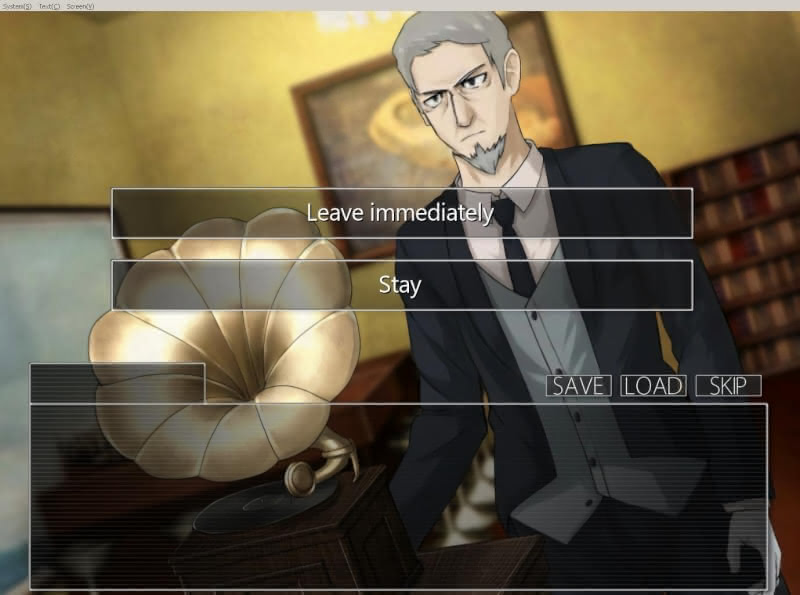
There are a few choices that are just for show. For example, there are a number of situations wherein the player, as Sen Ikeda, questions or interrogates a person on the island. At the beginning of the questioning, there are typically three choices. However, the player will ultimately be required to exhaust all of the choices, so the choice here amounts to little more than changing the order that information is provided.

It is not always immediately clear whether a choice will be decisive, and there are certain instances when the right answer is not immediately obvious.
Point and Click
Return to Shironagasu Island borrows from adventure games with some point-and-click sequences wherein the player must click around on a background to investigate things in the scene.

The good thing about the point-and-click sequences is that it is obvious what can be clicked on and there are always plenty items to click on. Contrast this with LoveChoice, a Steam visual novel I reviewed in early 2021, when I complained that it was sometimes not clear what could be interacted with in point-and-click sequences.
However, the point-and-click sequences have an annoying quirk. While there always items to click on, it is not always clear what precisely one needs to click on to advance the scene. Moreover, some things need to be clicked on multiple times, and sometimes after other things have been clicked on, meaning it is easy to get stuck in a point-in-click scene for a bit trying to figure out the correct order so as to advance the game.
Timed Events
Return to Shironagasu Island features a couple of timed events. While I cannot discuss the events in detail, one requires the player to solve a problem through regular multiple choice prompts within 5 minutes. Another requires the player to deal with a potentially dangerous situation within 5 minutes in a point-and-click affair. Both offer the player the opportunity to start from the beginning of the sequence if he or she fails.
Miscellaneous Interactions
There are a couple of quick-time events where the player must make a fast decision in Return to Shironagasu Island, although far fewer than in another Steam visual novel that I reviewed, ACE Academy. There are also a couple of scenes where the player must choose a character by clicking on the correct character’s name or portrait. Unsurprisingly for a mystery game where the player is a detective, these scenes are significant.
Aesthetics
While Return to Shironagasu Island was built with KiriKiri, which is, as I noted, which is a rather old visual novel engine. Nevertheless, the game itself, save for its built-in title bar, looks not only modern but quite good for what is an indie effort.
The backgrounds, while not objectively impressive, are clean and depict the visual novel’s various locales well.
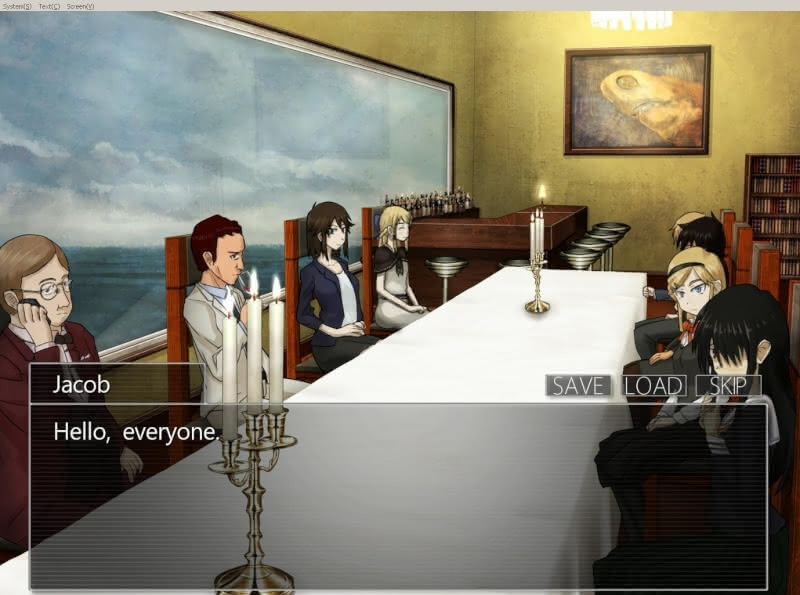
For the point-and-click scenes, the backgrounds are clean and detailed enough for it to be clear what the player can click on (the frustration in those scenes comes from needing to click on items in certain orders, not the inability to figure out what can be clicked).
The character models look good enough for all normal purposes, and that their mouths move when they talk and their eyes blink are nice touches. The characters do not display a great amount of emotional range, but most of the cast, with the exception of Neneko, have limited screen-time (note the game is played almost entirely from Sen Ikeda’s perspective). The artist did a notably good job of depicting characters from a number of countries. For example, Neneko looks Japanese, but the rest of the cast, with the debatable exception of a maid, do not look Japanese.
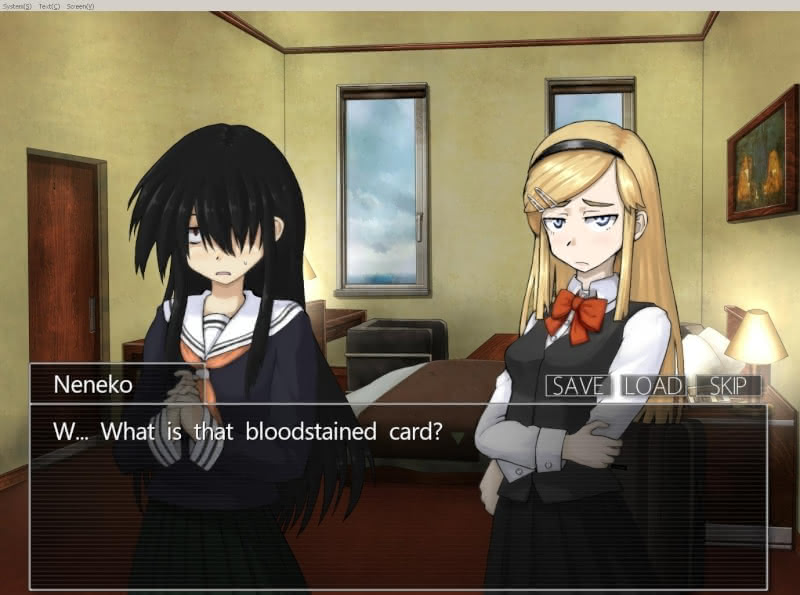
The most care went into Neneko’s design, and one may suspect from the sometimes-intense focus on Neneko’s appearance that the developer made the co-protagonist his “type” – a point which is mostly fine in the main game but ultimately harms the extra scenario (I will discuss the extra scenario further down in the review). Nevertheless, Neneko is unsurprisingly the most memorable character of the group in terms of her appearance.
The game features a total of 70 fully-drawn CG scenes, with the majority coming from the main game. These main game scenes depict key events in more detail than are in the bonus scenario, and they are often used to good effect in conjunction with lengthy interactions (e.g., interrogations). Some are the result of wrong choices leading to bad endings, meaning that the player will have to deliberately make bad choices to complete the CG library. These scenes are drawn with more detail than the regular game. Neneko and Akira Edgeworth, another guest of Shironagasu Island, benefit the most from the CG scenes in the main story, while a smaller number are from the bonus scenario.
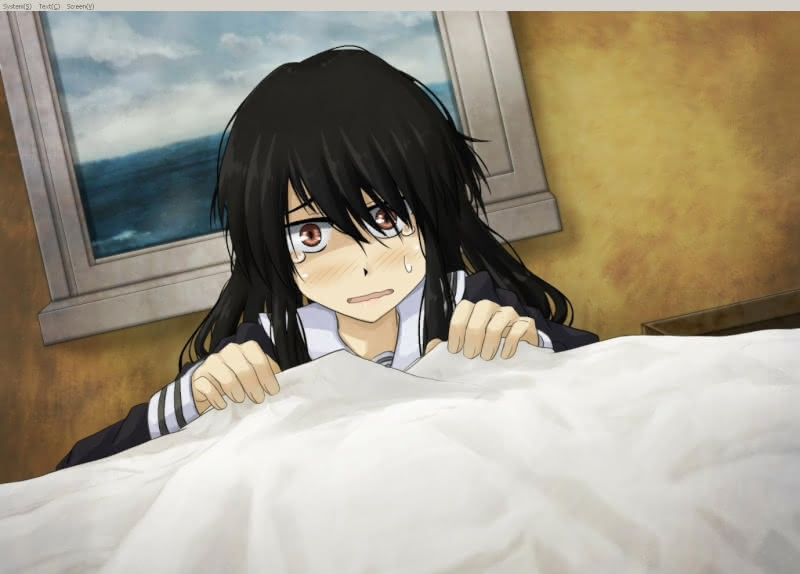
Without going into detail, I note that the designs for certain other characters in the mansion were a bit uninspired.
The background music for Shironagasu is fine but not particularly memorable. There were a few tracks for tense scenes that I recall liking while I was playing, but I do not remember them shortly after having finished. The sound effects are lacking, which is unfortunate in a horror game with a few designs on jump scares. Again – I note here that I am reviewing the original version, and it is entirely possible that some of the sound effects will be improved in the remastered release.
Note on Voice Acting
This is another reminder that I am looking at the original version of Shironagasu, not the new version being released in late 2022. The original version does not include voice acting – but I have no doubt that the revised version can benefit from its inclusion.
Save Slots
Return to Shironagasu Island provides 54 save slots. This is more than enough, and I did not come up against the limit (despite making saves for the purpose of returning to scenes for screenshots for this article) until I reached the latter stages of the extra scenario. For people who use saves solely to try different choices and avoid needing to re-do too much after a bad end (do note there is a skip function), 54 saves slots will be sufficient.
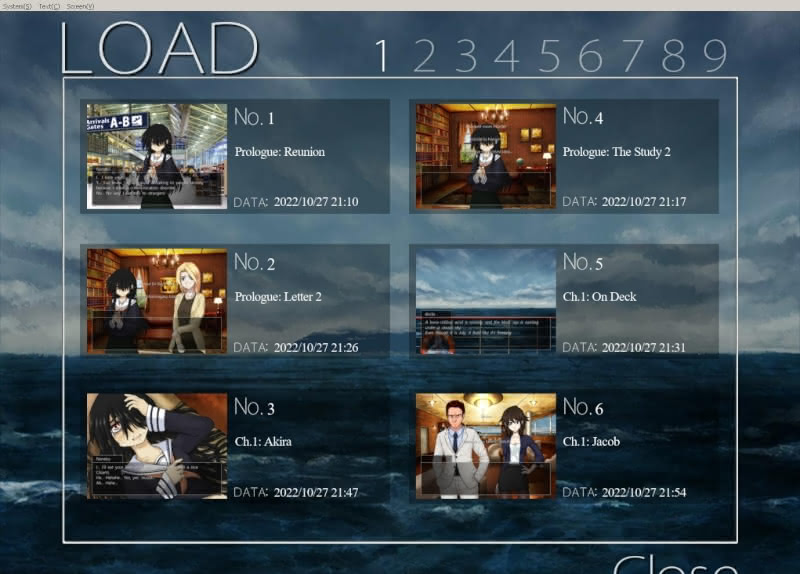
One small note on saves: To the best I could determine, you cannot save during the point-and-click scenes or timed events. However, this is not a major issue since the former cannot lead to bad ends and the latter has a retry option in the event of failure. There are a few special selection scenes which do not offer save functionality which can lead to bad endings in the latter half of the main game, making it advisable to put down save markers periodically when the action picks up.
Extras
Return to Shironagasu Island has an entire extra scenario which is unlocked by completing the main game. Like the extra scenario I noted in May Sky, it is fairly long (I would say roughly 40% the length of the main story). Beyond the extra content, there is a CG Library and a few basic configuration options.
My Overall Review
It is necessary to handle the main adventure of Shironagasu separately from the bonus content.
The main game, for reasons I will elaborate below, is a good mystery/horror visual novel on the whole, and I give it a qualified thumbs up. While it is not without its flaws in terms of how the story concludes and some of its handling of the main two characters, it more than justifies its full price of $5. For those buying on Steam, it is regularly on sale for less (note I would recommend also considering the Itch.io version since that is DRM-free).
However, if you are expecting a 10-hour affair instead of a 7-hour affair, about 40% of those 10 hours are attributable to the post-game bonus scenario. The bonus scenario, unlike the main game, is not good – and despite lacking blood, gore, and murder, it is more unpleasant to read. I explain why I do not like the bonus scenario in more detail below. Now one’s mileage may vary, and some may appreciate the somewhat zany comedy of the bonus scenario and have less issue with its treatment of the characters than I did. However, I advise potential buyers who see the 10-hour estimate for playtime to assume that they will be getting their money’s worth based solely on the 7ish-hour main story play time.
The Main Game
Return to Shironagasu Island has a very positive aggregate user review score on Steam, and on the whole, I will give the main game a thumbs up. While the mystery certainly does not adhere to the literary rules of mystery construction – especially once the true nature of Shironagasu Island begins to come to light – the author wrote it with care. None of the twists left me scratching my head, which is a credit to the fact that even if I did not predict it precisely, I could recall where it was previously foreshadowed. The mysteries make sense in the terms set by the story, which is more than can be said for many mysteries. The translation quality was excellent (speaking only in terms of how the game reads in English), and I do not recall any points where I was left confused about the meaning of one part of the text or another.
I enjoyed the atmosphere of Shironagasu as well. I have seen it compared to the Umineko series, which I shamefully (as of the writing of this review) have not read. However, I personally saw many similarities with Nine Hours, Nine Persons, Nine Doors, and anyone who has played that classic will understand what I mean (note: that is not to say that Shironagasu is on the same level as 999 or anywhere close to it, but few games are).
I found some of the characterizations and interactions to be a mixed bag. The player character, Sen Ikeda, is a capable detective, possessing good intuition and a strong physical constitution. He is certainly not the most common player archetype for a visual novel. With respect to handling mysteries, he worked well. In more light-hearted scenes, however, the author had some difficulty with Ikeda’s character.
The difficulty with Ikeda’s character comes up in a somewhat damaging way during his interactions with the real star of Shironagasu, Neneko. To be clear – given the reputation of certain visual novels and the author’s not-thinly-disguised affection for Neneko – I do not mean damaging in a creepy way. There is no sign at all that Ikeda has any sort of romantic feelings for Neneko, and many signs to the contrary. By somewhat damaging, I mean that after having spent about 10 hours with them, I was left not entirely clear what their relationship to each other actually is.
Firstly, I am not sure why Neneko, a high school student, is visiting Ikeda. They do not seem to be relatives. Did they meet in Japan? I am not sure. Secondly, Ikeda clearly does care for Neneko more often than not, so it does not make sense – even granting Neneko’s main fear was being left alone in a foreign country –when Ikeda takes her into what appears from the outset to be a dangerous situation. Thirdly, there are some circumstances in the mansion itself, when it is clear that they are in a life-or-death situation, where the game struggles to find a balance between Ikeda trying to keep Neneko’s head in the game (her assistance is sometimes the difference between life-and-death) and teasing her in situations when teasing is not appropriate. Finally, Ikeda’s lack of concern for the fact that Neneko hasa photographic memory and an resulting inability to easily un-see troubling things, makes him unlikeable at certain points (the game calls him on it at least once, and Ikeda notes it in some internal monologues, so at least there is some expressed awareness). None of these issues are game-breaking, but the failure to address or explain these aspects of the game’s central relationship is certainly a problem.
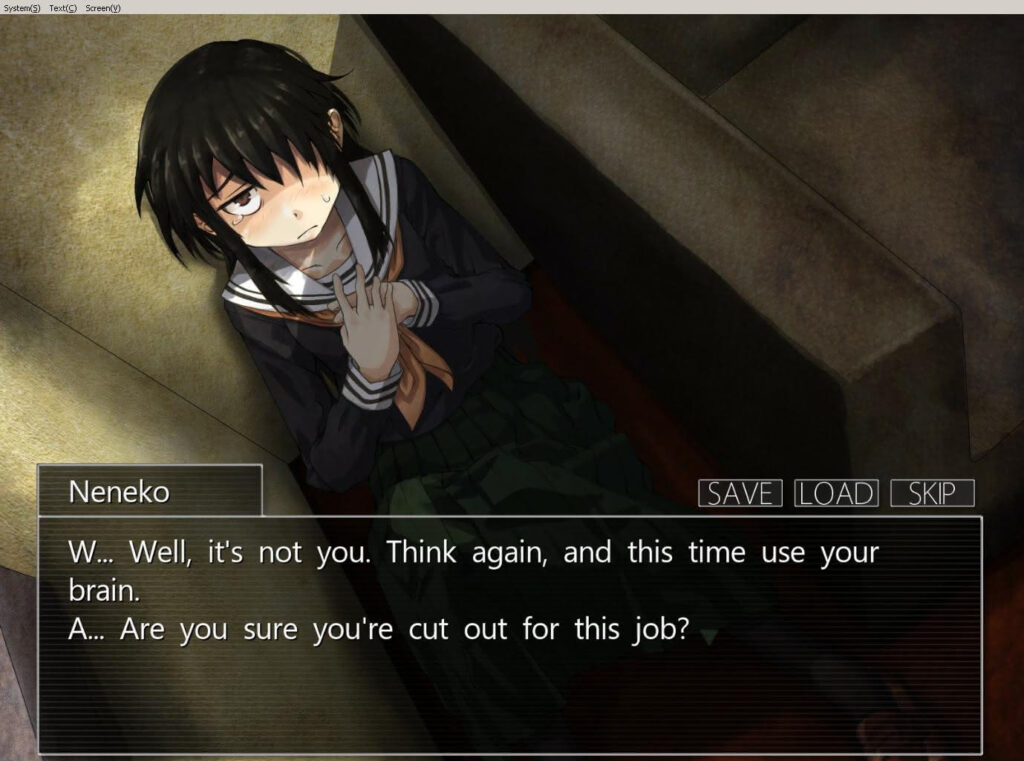
Although Neneko plays a supporting role to that of Ideka, she is nevertheless the true protagonist of Shironagasu, featured on all of the game’s promotional material and clearly having the complicated affection of her creator. Neneko is a well-defined character. She is a genius in some respects and has a photographic memory. To the game’s credit, while her photographic memory is important to solving some mysteries, it is not over-used, leaving most of the heavy-lifting to the player as Ikeda. She is painfully shy around everyone except Ikeda, has no social skills at all, and seems to have very little interest in resolving any of her social difficulties. (The reviewer who noted that the game was built with KiriKiri jokingly described Neneko as autistic. I suppose the joke could be supported, but I see no clear sign that this was the developer’s intent and in any event, it is certainly not a careful intentional case-study like the one I described in the Kimi ni Todoke anime.) While she is often on the receiving end of jokes, she has a sharp tongue in her own right. Neneko does not take care of her appearance or care for her person, both of which are noted by multiple characters. Despite her fear of being separated from Ikeda – initially caused by her not wanting to interact with other people and later by her fear of a painful, unpleasant death – she has her opportunities to prove that she is reliable when push comes to shove. Neneko’s issue is related to some of my concerns about Ikeda. The developer seems to enjoy making Neneko uncomfortable and twitchy, beyond what she would necessarily be even without being pushed. This manifests most often through Ikeda, but also through some other characters. This, on the whole, was not to Shironagasu’s benefit.
The rest of the cast is generally solid in their roles, although only some of the Shironagasu guests have enough screen time to receive significant development. To say which ones receive significant development would risk spoiling things – so I will say only that a few of the additional characters were memorable, and my view of the cast is positive enough outside of a few unspecified nefarious actors and/or actresses who reveal themselves later in the game.
I said my piece on the aesthetics in the previous part of the review. Regarding the game-play, I appreciated the fact that Shironagasu incorporated various interactive elements and ultimately made good use of all of them in important scenes – my one caveat with the point-and-click sequences being mildly frustrating having been already noted. I would have liked the interrogation/questioning sequences to be more dynamic, but that is a minor quibble. The way choices were handled at points where bad ends were possible was very well done. It was not always immediately obvious which choice was correct, but the story provided more than enough information to narrow the possibilities and to make the correct choice make sense in that context. Not knowing when a key point would come, or what form it would take, added an interesting layer to the mystery.
The mystery itself was fun to work through on the whole. I would have preferred that things stayed a bit more quaint, but I was glad to see that the entire mystery and its resolution remained contained to Shironagasu Island. That it reminded me at all of Nine Hours, Nine Persons, and Nine Doors is a complement (again – it is still a poor man’s version thereof), and while I would have made some different choices in the very late stages of the story, things remained intelligible and were resolved cleanly.
The Bonus Scenario
So, the main game is good on the whole, and for a visual novel murder mystery, it has some technical sophistication and polish. Do these generally positive impressions extend to the bonus scenario?
They do not. Not at all.
I am limited in what I can say about the bonus scenario, for noting any characters beyond Neneko would be a spoiler in and of itself (it should be obvious from everything I have written that you are not allowed to finish the game if you get Neneko killed). The bonus scenario takes a certain subset of the cast outside of Shironagasu Island after the events of the main story. While the main game, granting a few comedic digressions, is a serious affair with lives being at stake, the bonus scenario is an attempt at a comedy. I say the word attempt because with only a couple of exceptions, the comedy falls flat.
The bonus scenario has many problems, not least of which that if one takes it seriously, he or she will leave with a negative impression of all of the characters involved – including characters he or she may have grown to care about during their brushes with death on Shironagasu Island. Another issue is that the developers take the opportunity to focus on how they find Neneko attractive. The problem here comes in two forms. Firstly, the extra scenario makes a complete fool of Neneko in a way that goes beyond the line that was toed, but not irrevocably crossed, in the main game. Secondly, despite never crossing beyond PG-13 humor or content, one comes away from parts of the extra scenario feeling a more than a little bit uncomfortable with the developers’ insistence on embarrassing Neneko in a way that everyone except for Neneko understands to be embarrassing. Some of the other characters in the scenario receive similarly poor treatment, but the main heroine has the worst time of it for most of the short story.
(Shironagasu is a game that benefits from the writers caring about their characters. To say the writers do not care about Neneko and a few other characters in the extra scenario would be inaccurate. The issue, better put, is that their care is somewhat disordered.)
The bonus scenario requires us to accept that the people who showed courage and intelligence in surviving some extraordinarily harrowing circumstances on Shironagasu Island have become brain-dead in the aftermath. (Is it some sort of PTSD thing?) It is a little much even granting that the bonus scenario is, in large part, meant as a joke.
The only thing that I can credit the extra scenario – which is on the whole an unfunny and somewhat uncomfortable comedy – is that it did do some clever and unexpected things with choices in its final third. I was surprised when I discovered that the extra scenario not only has bad endings, but that they are more difficult to avoid than the bad endings in the main game. (I suppose it was good that I found a few neat design choices to compensate me for the brain cells that I lost in the first 2/3 of the scenario.) One of the potential bad ending routes was genuinely well done and reminded me of MYTH, a visual novel also available on Steam which I discussed briefly in an article about hair color.
The extra scenario was disappointing because had the developers opted to err on the side of writing a lighthearted story instead of self-indulgence, it could have succeeded as both a comedy and a way for readers to see some of the survivors of Shironagasu Island in a new light that was not possible under the circumstances of the main game. For example, I had a favorable view of the similarly structured extra scenario in May Sky, an older visual novel, because it both expanded on the story of the main characters, had some good comedy, and allowed us to see the characters in a way that was not possible in the main story. Even if Shironagasu had no designs on seriousness, it could have dialed down the bonus scenario’s tendency to make fools out of the main cast.
While the bonus scenario does not mar my views of the main story, it was, for the most part, a chore to read, and Shironagasu would not be a lesser product had it been omitted entirely. In my view, people who read through the main game in Shironagasu do not stand to miss out on anything other than a Steam achievement (assuming that they have the Steam version of the game) by passing on the bonus scenario, but some may get more mileage from the humor or some glimpses of clever horror game satire in its latter stages.
Interesting Note on Derivative Works
In the Readme file for Return to Shironagasu Island, the game’s author, Mr. Hyogo Onimushi, gave fans “permission to all kinds of non-corporate derivative works,” including some in genres which would not be amenable to publication on a family-friendly website (perhaps unsurprising given some of my complaints about the bonus scenario). Beyond allowing non-commercial derivative works, the author expressly stated that “all of your works are highly appreciated,” and he provides guidelines on the game’s official Japanese website. This information does not benefit me much since I can barely draw stick figures, but I thought it was a neat point worth noting for people who enjoy drawing game art and may not have gone through the trouble to browse the game’s files post-install. However, do note that the game itself is copyrighted, and this permission only extends to derivative works under the terms specified in the Readme.
Conclusion
This concludes my review of Return to Shironagasu Island. It was timely in the sense that I finished the game minutes before Halloween 2022 and put the review out on Halloween proper. It was untimely in that I only learned right after finishing that we are on the precipice of a new-and-improved version of Shironagasu.
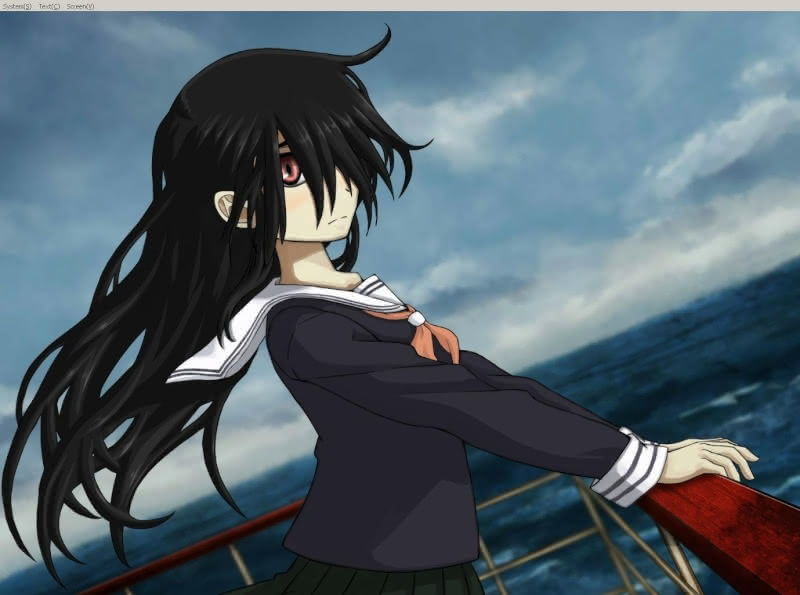
On the whole, despite my desire to discard the long bonus scenario, I enjoyed Shironagasu and I think that the main game justifies its full price tag, much less its price when it goes on sale. If you generally enjoy mystery visual novels with a touch of murder, Shironagasu is well-worth playing. It also has several interesting design elements and structural choices for those who are interested in visual novels generally, if not the specific genre. For those who have little experience with visual novels, Shironagasu is a decent place to start since it invites plenty of player input, is not excessively long, and is readily available on Steam. I credit Mr. Hyogo Onimush and the team at Tabinomichi for an impressive (and very generously-priced) indie visual novel effort.
In a visual novel history note, I point again to the fact that Shironagasu is built on KiriKiri. I think that it is neat that new and modern visual novels are still being built on what is now an old engine, especially in light of the fact that I reviewed a much older KiriKiri project as part of my al|together series and have a few more in the pipeline (fortunately, Shironagasu does not require a Japanese runtime environment like the other KiriKiri games I am playing).
While I am not committing to it, I may take a look at the new-and-improved version of Shironagasu, which will have full voice acting, after it is released. Whether I decide to read through it will depend on (A) where it is available and (B) whether there is any additional content beyond voices. If I do, I may post a separate review of the new Shironagasu, in which case I would update this post with a link to the successor review.